Outline for Foundations of Reading Mtel Essays
The Foundations of Reading examination is designed to measure a candidate's knowledge of the reading and linguistic communication arts required for the Massachusetts Early on Babyhood, Unproblematic, and Moderate Disabilities licenses.
Format:
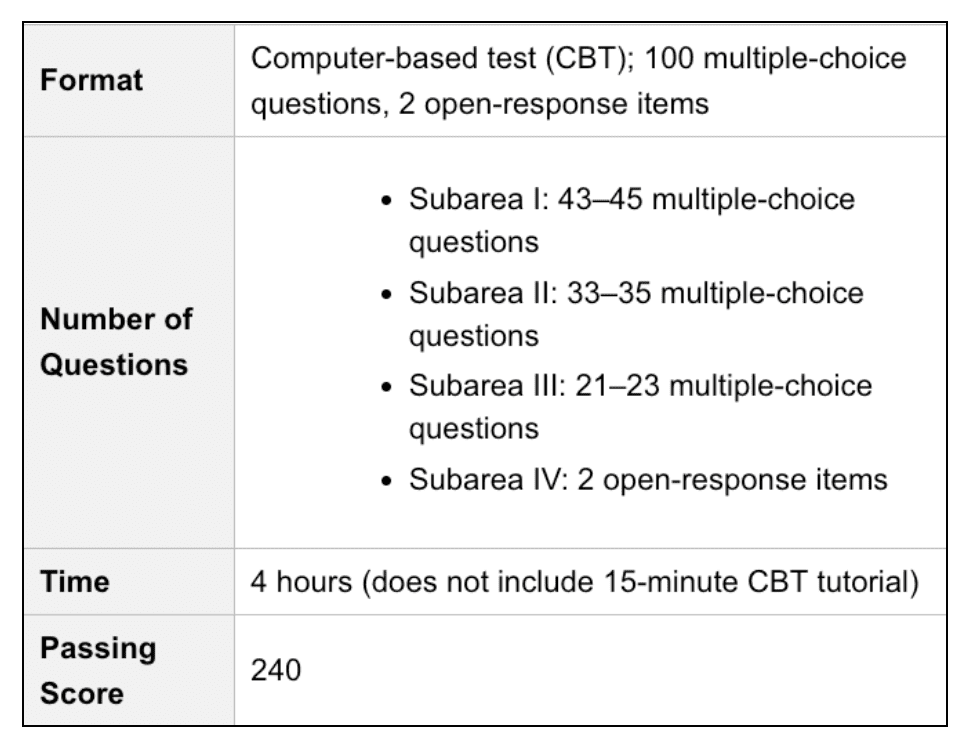
https://www.mtel.nesinc.com/Content/StudyGuide/MA_SG_OBJ_90.htm
Price:
$139.00
Scoring:
Candidates applying for Massachusetts licensure must score 240 or higher to laissez passer the examination. Your score is based on the number of items answered correctly beyond all subareas of the test and is converted to a scale that ranges from 100-300. You volition receive a report that details your performance on each subarea department of the examination for both open-ended response items, as well as the multiple-choice sections.
Pass charge per unit:
Out of the four,136 candidates who took the Foundations of Reading test during the 2016-2017 twelvemonth, 65.9% passed.
Study time:
To pass the exam, there is no set time to study. It depends on the strengths and weaknesses of the participant in relation to the skills covered on the test.
Plan a class of study by focusing on your weaknesses. The best way is to review the 240Tutoring materials.
What test-takers wish they would've known:
- Test-takers tend to overestimate their abilities to perform well. Many students regret not putting more time and effort into preparing. Fortunately, information technology'due south easy to avert this mistake by using exam training materials.
- When answering the multiple-choice questions, you should read all possible answers before mark the correct 1. Y'all don't desire to miss out on the best answer by non reading all of the responses!
- E'er check your answer before moving to the next question. Many test-takers are surprised by how they're able to find overlooked errors in their piece of work by using this strategy.
Information and screenshots obtained from the Massachusetts Tests for Educator Licensure website:
https://www.mtel.nesinc.com/Dwelling.aspx
Subarea I accounts for about 35% of the exam.
This subarea has four objectives:
- Phonological and Phonemic Awareness
- Concepts of Impress and the Alphabetic Principle
- Phonics
- Word Analysis
So, let's start with Phonological and Phonemic Awareness.
Phonological and Phonemic Sensation

This department tests your knowledge on phonological and phonemic awareness including merely non limited to:
- the departure between phonological and phonemic awareness
- strategies to support phonological and phonemic awareness skills
- levels of phonological and phonemic awareness skills
Let'southward discuss some concepts that volition more than probable announced on the test.
Phonological Sensation
Phonological sensation can be described every bit a student's power to recognize and work with sounds. It is a vital skill necessary for reading success.
Phonological awareness can exist broken into three components:
- the onset/rime construction of words (the word hathas an onset of "h" followed by the rime of "at")
- how words can exist broken into syllables
- how sentences can be broken into words
Reading begins when students tune into the sounds of spoken language; this is why phonological awareness is and so of import to a child's reading success.
During the earliest stages of developing phonological sensation, children can pick out rhyming words and count the number of syllables in a proper noun. Children will also be able to notice when sounds repeat themselves (alliteration). For case:
Sally sold seven savory sandwiches.
In a more developed phase, phonological awareness transitions from
being aware
to
doing
. For example, rather than just being aware of rhyming words, children can generate rhyming words, every bit well as break words apart into single sounds (syllables).
Phonological awareness instruction should include:
- modeling how to say each sound
- quick mistake correction
- individual assessments
- explicit education beforeand
during
education
- guided practice and review
- unlike types of activities
- use of physical objects (puppets, counters, cue cards, etc.)
Phonemic Awareness
Phonemic awareness is the power to recognize, contemplate, and work with private sounds. Teaching in phonemic awareness should exist focused on helping children recognize and work with phonemes.
Take a look at the normal progression of phonemic awareness skills:
- develop an sensation of sounds
- blend words with a prompt (pelting + bow → rainbow)
- blend single syllable words with a prompt (/h-a-t/ → lid)
- recognize like sounds (/ch/ in cheese and /ch/ in chair)
- interruption apart one-syllable words (hat → /h-a-t/)
- isolate the beginning sound of a word (place /d/ as the first sound in dog)
- change the first sound to create new words (change hat → sabbatum, bat, cat)
- isolate the final audio of a word (identify /t/ as the ending sound in hat)
- change the catastrophe audio to form new words (modify had → hat)
- isolate the centre vowel sound (identify /o/ equally the middle audio in hop)
- blend ii-syllable words (alloy /p-o-c-k-e-t/ → pocket)
- rhyme one-syllable words (hat, bat, sabbatum, pat, cat)
Blending
Blending is the skill of combining sounds to brand a written or spoken discussion. It'due south a specific phonemic sensation skill that needs to exist taught early on. Blending is necessary for fluent reading, so words tin be decoded effectively.
Take a await at these examples of blending:
/h-a-t/ → chapeau
/m-i-t/ → mit
/t-u-b/ → tub
Concepts of Print and the Alphabetic Principle
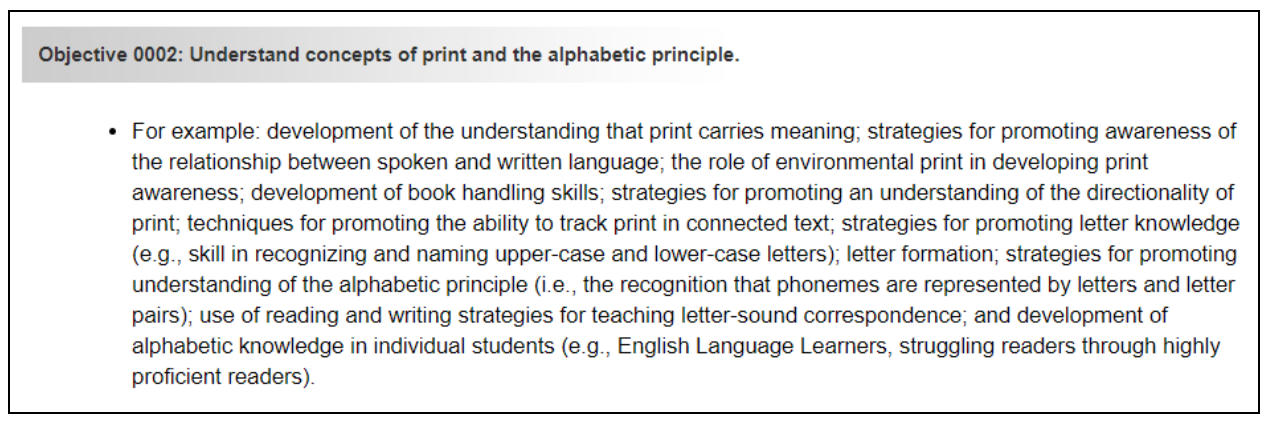
This section tests your knowledge of the alphabetic principle and concepts of print. This includes merely is non express to:
- environmental print
- tracking
- upper and lowercase letters
- volume handling skills
- strategies to teach the awareness of the relationship betwixt spoken and written words
Let'southward expect at some concepts that are guaranteed to come up on the test.
Environmental Print
Environmental print is the print of everyday life. It's what we call print that appears on signs, labels, and logos. For many children learning to read, environmental print helps class a connection between letters and sounds. For case:
A child who sees the KFC sign recognizes the letters M, F, and C and makes a connection between those letters and the outset sounds in Kentucky, Fried, and Chicken.
Alphabetic Principle
The alphabetic principle is the idea that letter patterns and single letters represent sounds of spoken words. Once children understand the relationship between sounds and letters, they are equipped to read with greater fluency. For case:
The word hat is made up of the sounds /hhhh/, /aaaa/, and /tttt/
Tracking
Tracking is the ability to read and write from left-to-right. Children who track efficiently will look at AND process words and letters in order from left-to-correct. This is an essential reading skill because letters and words will not have the correct relationships if students are not tracking properly.
Phonics
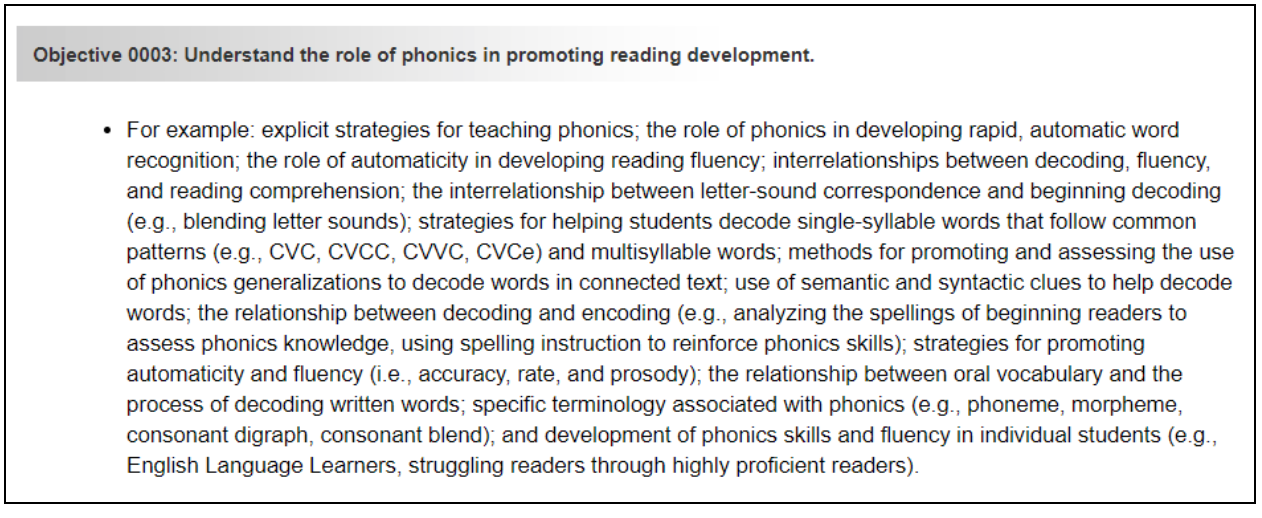
This section tests your knowledge of the role of phonics in promoting reading development. This includes but is not express to:
- automaticity
- decoding vs. encoding
- fluency
- common word patterns
- blending letter sounds
Let'due south await at some concepts that are guaranteed to come on the test.
Automaticity
Automaticity is the power to
speedily
AND
accurately
identify words. Automaticity develops more and more than as children read. It does non include reading with expression and is not the same thing as reading fluency. Automaticity is necessary for developing fluency and then that children can read with meliorate expression and more than fluidly.
Decoding versus Encoding
- Decoding is converting symbols (messages) to sounds in spoken language.
- Encoding is converting sounds to symbols (letters/words) in written language.
Decoding and encoding rely on a educatee's phonological sensation which includes their understanding of sounds, letters, and how both work together to create spoken and written language.
Fluency
Fluency is the ability to read text speedily, accurately, and with expression. Fluency is of import because it provides the bridge between recognizing a word and understanding the context and pregnant of the word.
Here are the components of fluency:
- prosody– reading sentences/words with the appropriate expression
- accuracy– reading words correctly
- automaticity– reading words accurately and quickly
Let's wait at some strategies for effective fluency education:
- pre-teach vocabulary
- provide a variety of books and materials to read
- record students reading aloud
- instruct students to rail using a ruler or finger
- drill sight words
- provide opportunities for students to reread materials
- read aloud to students consistently
Common Discussion Patterns
Discussion patterns are predictable patterns of sounds (consonants and vowels) that form words.
For instance:
CVC- A consonant is followed by a vowel and some other consonant to create a syllable, usually with a short vowel sound (
bat, top, kid
).
CVCe- Same as above, just a silent
east
is found at the end of the discussion. This normally makes the vowel of the word long (
hike, tone, make
).
CVCC- Here you take words that stop with two consonants (
cart, best, half
).
Understanding word patterns strengthens a child's phonological and phonemic awareness which, in plow, strengthens a child's reading fluency.
Word Analysis
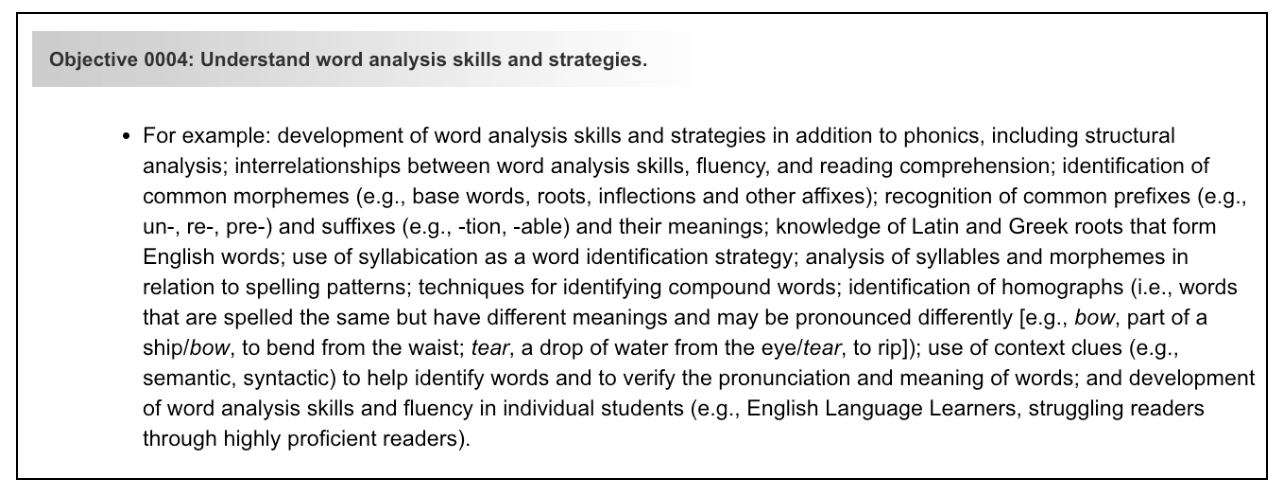
This department tests your knowledge of word analysis skills and strategies. This includes only is not limited to:
- context clues
- syllabication
- homographs
- spelling patterns
- compound words and homographs
- using context clues to identify multiple pregnant words
- recognizing mutual prefixes and their meanings
Here are some specific concepts that will more than likely appear on the examination.
Context Clues
Context clues are the office of reading comprehension that involves using the other words in a judgement or passage to understand an unknown give-and-take or words. Usually, a author will include hints to help the reader understand the significant of the word or phrase. When children use context clues to help them place words, they use pictures or judgement context. For instance:
Bob put his jacket on.
This judgement would probably exist on the same page with a motion-picture show of Bob putting his jacket on. A kid may non recognize the word
jacket
, but the film helps with identifying the unknown word.
Syllabication
Syllabication is the partitioning of words into syllables; this makes unfamiliar words easier to read. It is of import to recollect that a syllable has a vowel sound, so each syllable will contain a vowel. For instance, the word
mumble
has ii vowels (u,east) and tin be broken into two syllables:
mum/ble
Homographs
A
homograph
is a word that has the same spelling as another word but has a different audio and a different pregnant.
Permit's look at some examples:
- atomic number 82 (to go in forepart of) and lead (a metal)
- current of air (to follow a course that is not directly) and current of air (a gust of air)
- bass (low, deep sound) and bass (a blazon of fish)
Students must use context clues when identifying the appropriate use of homographs.
Subarea Ii accounts for about 27% of the examination.
This subarea has three objectives:
- Vocabulary
- Comprehension and Imaginative/Literary Texts
- Comprehension and Advisory/Expository Texts
So, let's get-go with Vocabulary.
Vocabulary
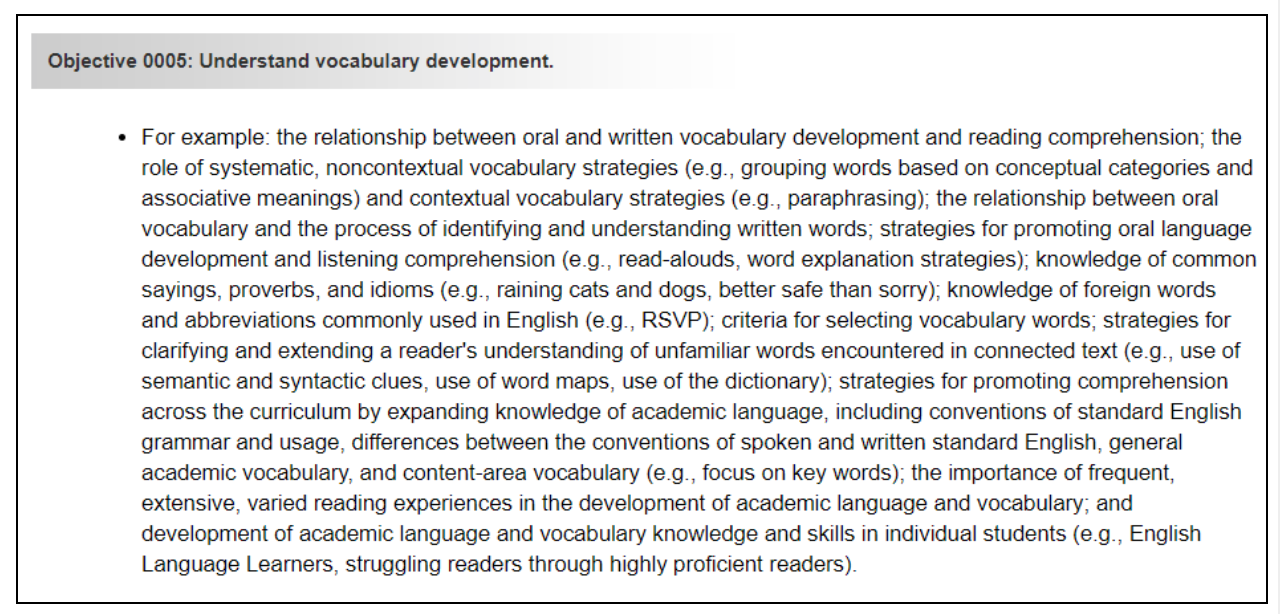
This section tests your knowledge on vocabulary evolution. This includes but is not limited to:
- knowing the human relationship between oral and written vocabulary development
- understanding common sayings including idioms and proverbs
- knowing foreign words and normally used abbreviations
- understanding strategies for promoting comprehension across curriculum past expanding knowledge of academic vocabulary
Let'south discuss some concepts that will more than than likely appear on the test.
Word Maps
A give-and-take map is a manner to visually organize vocabulary that specifically promotes vocabulary development. Word maps assist in students' vocabulary development considering they encourage the students to think well-nigh vocabulary terms and concepts in several ways. They also assist students build on prior cognition, equally well as visually correspond new information.
Virtually word maps crave students to:
- define the word
- list synonyms and antonyms for the word
- draw a picture to stand for the word or concept
Here is an example of a word map:
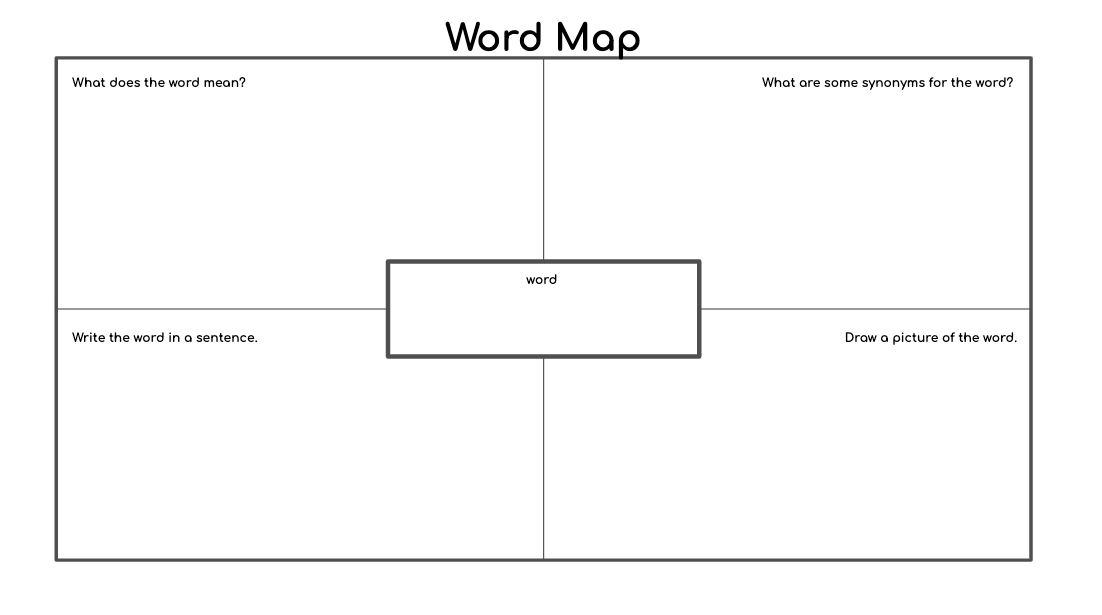
Academic Vocabulary
Academic vocabulary refers to words that are commonly used in the classroom. These types of words are used to explain a concept but are not typically used in non-academic conversations.
Here are some examples of academic vocabulary:
- analyze
- category
- cite
- label
- summarize
- contrast
- conclude
- contrast
- structure
Oral Linguistic communication Development
Oral language refers to the system through which nosotros use spoken words to express what nosotros know, our ideas, and our feelings. It is vital that young readers develop potent oral linguistic communication skills because listening and speaking skills accept a strong connection to writing and reading comprehension.
Here are the components of oral language:
- morphological skills- understanding the meaning of word forms and parts
- phonological skills- the sensation of sounds
- syntax- understanding word society and grammar rules
- pragmatics- understanding the social norms of spoken and written language
- semantics (vocabulary)- understanding the meaning of words and phrases
Let's wait at the 5 stages of oral linguistic communication development:
- silent/receptive- children are listening to but non using the linguistic communication
- early on production- children will brainstorm using curt phrases with many errors and will learn upwardly to 1,000 words
- speech communication emergence- children will learn fifty-fifty more words and will brainstorm to use phrases more than confidently and with fewer grammatical errors
- intermediate fluency- children begin to communicate in written form, every bit well as develop more than complex sentences
- advanced fluency- children will demonstrate mastery of written and spoken linguistic communication; they need frequent opportunities to express themselves in writing, as well every bit in spoken language to maintain their language skills
Now, allow's look at some strategies for promoting oral language development:
- provide direct phonological sensation pedagogy
- expose students to language as oft as possible
- provide students with a wide range of print materials; students who are exposed to a diversity of materials develop language more than quickly
- encourage conversation; provide students the opportunity to do the linguistic communication
Comprehension and Imaginative/Literary Texts
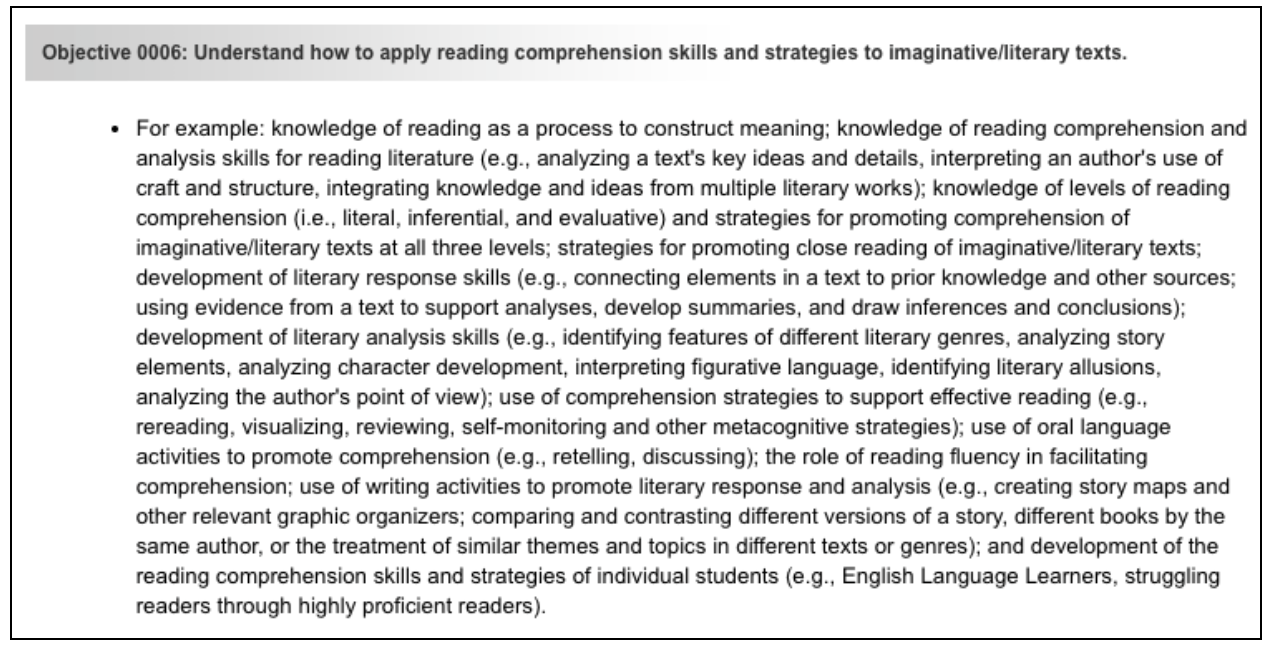
This section tests your noesis on how to apply reading comprehension skills and strategies to imaginative/literary texts including simply not express to:
- types of comprehension
- story elements
- literary allusions
Accept a wait at these concepts.
Types of Comprehension
Reading comprehension tin be broken into three levels. Each type of reading comprehension is important because a reader needs all three in order to truly cover what he/she is reading.
Here are the three types of reading comprehension:
- literal- understanding text in the near basic sense; agreement the meaning of the words, the context, the main idea, and the sequence of events
- inferential- understanding the undisclosed meaning of text and so using that significant to brand inferences
- evaluative- understanding to the extent of being able to provide a response based on the reader's opinion
Story Elements
Here are the five story elements of fictional text:
- characters- the participants in the story
- setting- when and where the story takes identify
- plot- the storyline or main events
- disharmonize- the problem of the story
- resolution- how the trouble is solved
These elements hook the reader'due south attending, keep the story flowing, and allow for a logical sequence of events.
One of the best ways to teach story elements is to signal them out while reading to your students. It is important to "think out loud" and model for your students as you identify the different story elements.
You can also ask students to place each element in the fiction books they are reading; try challenging students to write their ain stories with story elements.
Literary Allusions
Literary allusions are used by authors to make an indirect reference to a figure or outcome. Usually, allusions are made to past events or figures. For example:
" Y'all're acting similar such a Scrooge !"
This allusion references Charles Dickens'south
A Christmas Carol
. The line means that the person is being selfish and grumpy, just similar the character, Scrooge, from the story.
Hither's another case:
"I didn't have any coin for the bus, but fortunately a skilful Samaritan helped me out!"
This allusion references the biblical story of the skilful Samaritan helping someone in need.
Comprehension and Informational/Expository Texts
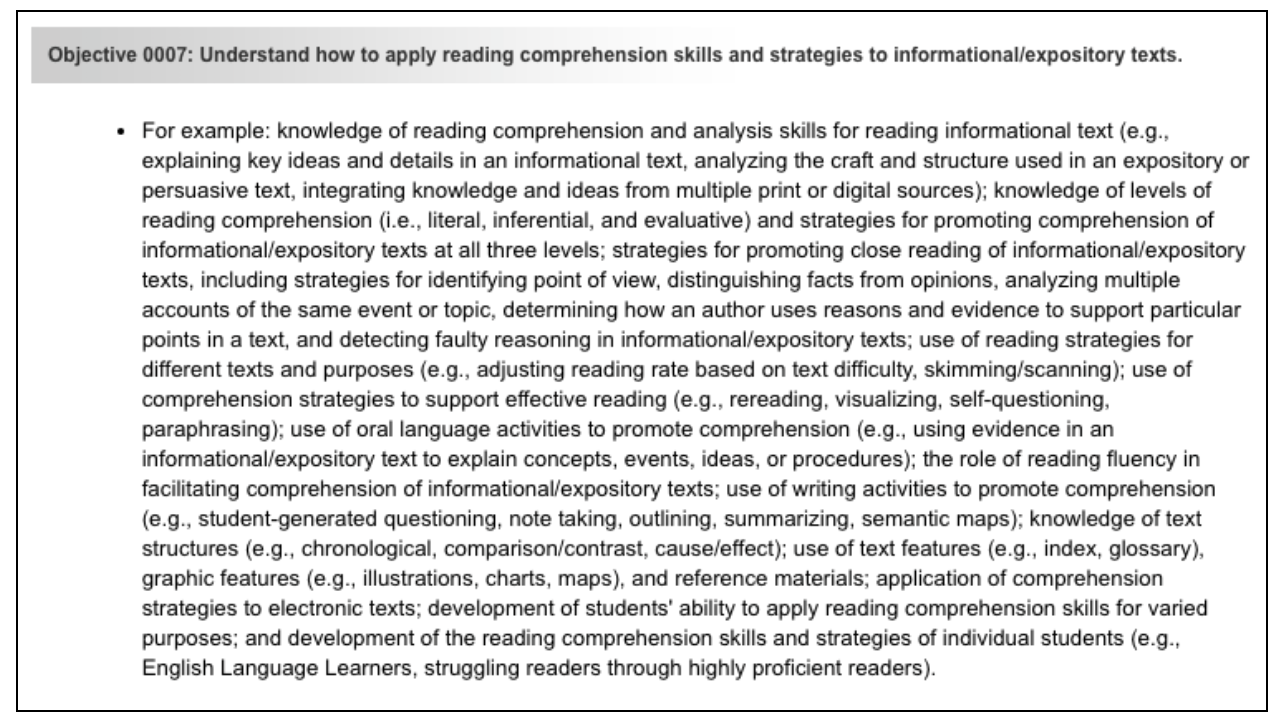
This section tests your ability to utilise reading skills and strategies to informational texts including but non limited to:
- fact vs opinion
- text structures
- text features
Let's discuss some concepts that may announced on the exam.
Fact versus Opinion
A fact can be proven true or false. An opinion is an expression or particular feeling of an individual that tin not exist proven. Opinion statements typically include signal words similar:
- always/never
- believe
- estimate
- should
- good/bad
- might
It is important for students to recognize indicate words when determining if a statement is a fact or opinion.
Let's await at both a fact and stance statement.
Fact:
The sky was blue on Monday.
Opinion:
The heaven was the most cute shade of bluish on Monday.
Text Features
Text features are all the components of a story or article that are not the primary torso of text. Features of text include the:
- Title– tells the topic of the text
- Tabular array of contents– shows where to discover different topics within the text
- Alphabetize– shows where to find specific information, words, or characters
- Glossary– defines vocabulary
- Pictures and captions– highlights of import ideas from the text
- Diagrams/charts/graphs– reinforces important information/data from the text
- Maps–
helps the reader sympathise the context of the text past agreement the location
Text Structures
Text construction refers to how a piece of text is organized. Instruction students to recognize common text structures helps students to non only monitor their level of comprehension only also understand the main thought and details of a given text.
Here are the common text structures for expository text:
- description–
describes
a certain topic
- sequence–
lists events
in sequential society
- problem and solution–
poses a problem and suggests a solution
- crusade and effect– presents the
relationship
between a specific event or thought and the events that follow
- compare and dissimilarity– focuses on the
similarities and differences
between two or more people, places, ideas, events, etc.
Subarea III accounts for most eighteen% of the examination.
This subarea has two objectives:
- Assessment Methods
- Reading Didactics
Then, let'south start with Cess Methods.
Assessment Methods
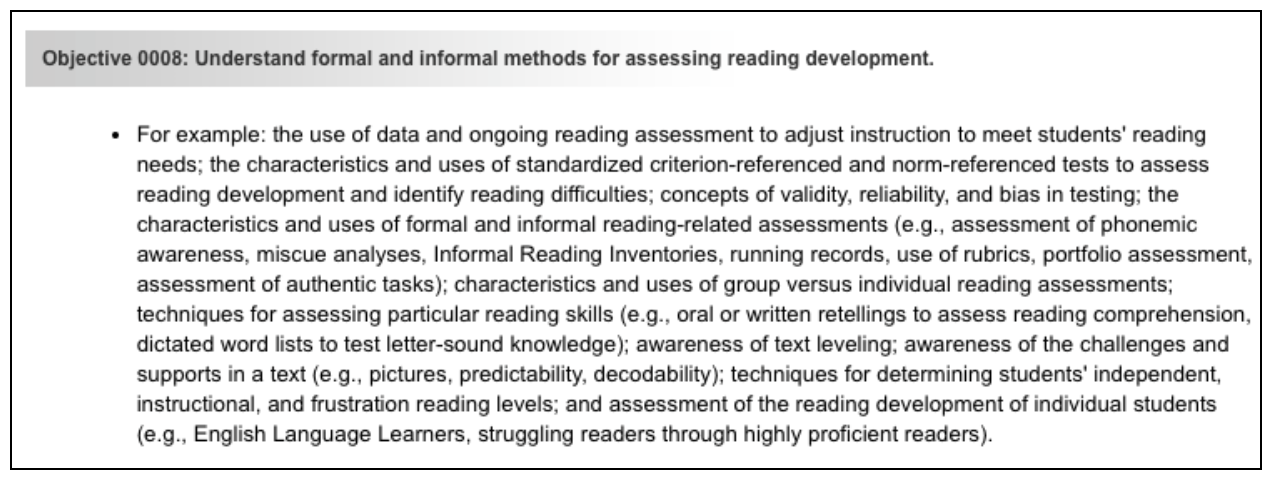
This department tests your cognition of using formal and breezy methods to appraise reading evolution. This includes but is non limited to:
- running records
- assessing reading levels
Hither are some concepts that may appear on the test.
Norm-Referenced versus Criterion-Referenced Assessments
A norm-referenced cess compares a educatee'due south score to that of their peers. This blazon of assessment is
typically reported in percentiles
that detail how a educatee scored in relation to the rest of their peers. The results will non be in pass/fail format.
A criterion-referenced cess assigns a
specific score
to a pupil's operation on a grade-level standard. The goal of this type of assessment is to
determine mastery of a specific skill.
The results will unremarkably be "pass" (met standard) or "fail" (did non run across standard).
Running Record
A running record is a way to assess a student's reading level. While a educatee reads aloud, the teacher listens and assesses fluency and identifies error patterns.
There are a few dissimilar systems for taking running records. About crave the teacher to provide a student with a specific, leveled passage then heed to the kid read aloud for a set amount of time. While the educatee reads, the teacher keeps a tape of mistakes and takes notes. This data provides insight into fluency (accurateness, automaticity, prosody).
Keeping a record of students' reading progress will assistance you continually evaluate your students' strengths and weaknesses, so you can provide intentional and targeted reading instruction.
For an case of a running record, too as how to score a running record, check out this resource: https://world wide web.readinga-z.com/helpful-tools/nearly-running-records/marking-a-running-tape/
Reading Levels
Students will read on i of three levels: independent, instructional, or frustrational. Permit's look at each one:
- contained- the text is non challenging for the student to read; the pupil makes few to no errors when reading this text (95-100% accuracy); it is the highest level you would expect a child to read with little to no help
- instructional- the student will have some groundwork cognition of the topic and can read the text fluently with minimal back up and errors (90-95% accurateness)
- frustrational- the topic of the text is unfamiliar to the student due to a lack of background knowledge; the educatee makes multiple errors (less than 90% accurateness) while reading and requires moderate to intensive support
The all-time style to monitor reading levels is to assess students' levels frequently. Teachers practise this by:
- taking running records
- tracking fluency
- listening to students read
- asking specific questions near text to monitor students' comprehension
Reading Teaching

This department tests your cognition of the multiple approaches to and components of reading instruction. This includes but is non limited to:
- flexible grouping
- text complexity
- differentiation
Permit's talk over some concepts that may announced on the examination.
Flexible Grouping
Flexible grouping is an instructional strategy that divides students into groups based on unlike factors that are determined by the teacher. Using mutual sense when grouping is important, and a instructor should always choose the near effective method to deliver instruction.
Flexible groups can exist:
- pupil or teacher-led
- organized according to skill level or need
- varied in size
- cross-grade or cross-form level
Flexible group provides students with the opportunity to work with other students, but information technology besides provides teachers with the opportunity to deliver specific and differentiated didactics to a targeted grouping of students.
Text Complexity
Text complexity is a organization that determines how challenging a text is for a child at their specific reading level.
There are 3 factors used to determine the complexity of a text:
- qualitative measures– includes text structure, knowledge demands, language clarity, and levels of meaning
- quantitative measures– usually measured by Lexile level
- reader and task-the motivation, involvement, and groundwork cognition of an average reader at a particular grade level
Students volition read through a text sequence, and as they do and so, they will acquire vocabulary as well every bit gain a deeper comprehension of more difficult texts in a given ready. Sequenced texts are a slap-up tool for teachers to use and then that students are able to progress in a style that is clear and beneficial to their overall fluency and reading evolution.
Differentiation
Differentiation is an effort by a teacher to meet the specific academic needs of each student in his/her class. Students enter classrooms with varying levels of proficiency, so it is critical that teachers come across students where they are at in their learning.
Teachers can differentiate instruction by adjusting the:
- content- what the student is expected to learn (leveled reading materials, spelling lists, reading buddies, small group instruction, etc.)
- process- activities that support students acquiring the content (passion projects, leveled activity centers, offering manipulatives, etc.)
- expected products- the way students demonstrate mastery of the content (create a puppet show, write a poem, let students to work independently or in a group, etc.)
- learning surround- the manner the classroom is prepare (providing spaces for grouping and contained work, establishing routines, assuasive students to sit where they larn best, providing materials that correspond various cultures/backgrounds, etc.)
Subarea 4 accounts for near 20% of the test.
The open-concluded response portion of the examination contains two written assignments. Information technology is important that you read and respond to each part of the question and record your response as instructed. Also, be sure to read the background information given to you lot and attempt to use specific terms from the question.
Let'south say you are given a scenario where a 3rd-grade student has read a passage aloud, and his teacher is taking a running record. You are shown an example of the running record and are asked to:
"Use your cognition of give-and-take identification strategies, and identify one of Jonathan'due south strengths and ane of his weaknesses."

Exist sure to:
- cite specific evidence from the information yous were given
- demonstrate an agreement of the field
- demonstrate the depth of your understanding of the subject area surface area (reading educational activity)
- Non just recite factual information
Your responses will be evaluated based on the following criteria:
- Purpose:the extent to which the response achieves the purpose of the assignment
- Subject noesis:ceremoniousness and accuracy in the application of subject knowledge
- Support:quality and relevance of supporting bear witness
- Rationale:soundness of argument and degree of understanding of the subject field area
Source: https://www.240tutoring.com/foundations-of-reading/mtel-foundations-of-reading-practice-test/
0 Response to "Outline for Foundations of Reading Mtel Essays"
Post a Comment